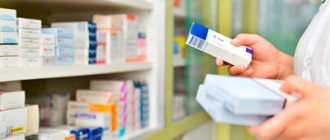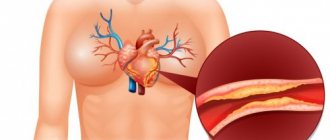Composition and release form
The medicine is flat round white tablets. There is a dividing line on the front side. The corner is a little skewed. This chamfer makes the tablet easy to swallow. The letter D is engraved on the reverse side. The drug is sold in bottles. Each bottle contains 50 tablets.
The main active ingredient of the drug is digoxin. Auxiliary elements have been added to it. 1 tablet contains 0.25 mg of digoxin. It is obtained from raw materials of foxglove (Digitalis lanata). This perennial plant contains many cardiac glycosides that are used in medicine.
Digoxin is also available as a solution for injections. The amount of digoxin in it is 0.25 mg. It is supplemented with injection water, ethyl alcohol, glycerin and citric acid.
This medicine is a cardiac glycoside that normalizes blood pressure, rhythm and heart sounds. Digoxin has a beneficial effect on the heart muscle and belongs to the group of cardiotonic drugs.
Digoxin price, where to buy
Buy Digoxin tablets 50 pcs. possible for a price of about 60 rubles.
- Online pharmacies in RussiaRussia
- Online pharmacies in UkraineUkraine
- Online pharmacies in KazakhstanKazakhstan
ZdravCity
- Digoxin tab.
0.25 mg 30 pcs Usolye-Sibirsky Chemical Pharmaceutical Plant JSC 42 RUR order - Digoxin tablets 0.25 mg 30 pcs. Pharmstandard-Tomskkhimpharm/Pharmstandard-Leksredstva OJSC
39 RUR order
- Digoxin tab. 0.25 mg 50 pcs JSC Gedeon Richter / Gedeon Richter-RUS JSC
60 rub. order
- Digoxin tablets 0.25 mg 56pcs AO PFC update
67 RUR order
Pharmacy Dialogue
- Digoxin (tablet 0.25 mg No. 50)Gedeon-Richter
56 RUR order
- Digoxin (tab. 250 µg No. 30) FS.-Leksredstva
42 RUR order
- Digoxin (tablet 0.25 mg No. 30) FS.-Tomskkhimpharm
42 RUR order
- Digoxin (tab. 0.25 mg No. 56)Update of PFC JSC
62 RUR order
show more
Pharmacy24
- Digoxin 0.25 mg No. 40 tablets PAT NEC "Borshchagivsky chemical and pharmaceutical plant", Kiev, Ukraine
7 UAH. order
PaniPharmacy
- DIGOXIN tablets Digoxin tablets. 0.1 mg No. 50 Ukraine, OZ GNTsLS LLC
9 UAH order
- DIGOXIN ampoule Digoxin solution d/in. 0.025% amp. 1ml No. 10 Ukraine, OZ GNTsLS LLC
39 UAH order
- DIGOXIN tablets Digoxin tablets 0.25 mg No. 40 Ukraine, Borshchagovsky Chemical Plant PJSC
9 UAH order
- DIGOXIN tablets Digoxin tablets 0.25 mg No. 50 Ukraine, Health LLC
11 UAH order
show more
How it affects the body
Digoxin inhibits and blocks the enzyme sodium-potassium adenosine triphosphatase. The task of Na+/K+ ATPase is to remove sodium ions from myocardial cells. When the activity of this enzyme is inhibited, the amount of sodium (Na+) in the muscle cells of the heart increases dramatically. Thanks to this, channels open in the cells through which calcium (Ca2+) enters the cardiomyocytes. Due to excess sodium, calcium accumulates very quickly in the membranes of heart muscle cells. High levels of calcium in myocardial cells inhibit the effects of the troponin complex, which prevents the mutual influence of two important proteins - myosin and actin.
Due to this complex mechanism, the myocardium begins to contract stronger and faster. Thanks to this, blood circulation improves: stroke and minute volume of blood flow increases. Systolic and diastolic volumes of the heart are reduced. The myocardium decreases in volume, but its tone increases, so the heart muscle begins to need less oxygen. Systolic output increases.
Digoxin reduces the heart rate during atrial fibrillation and has a beneficial effect on hemodynamics both inside the heart and throughout the body.
Positive effect of Digoxin:
- it becomes easier for the patient to breathe in a lying position;
- the pressure in the vena cava, pulmonary artery and right atrium decreases;
- heart rate normalizes;
- shortness of breath decreases in chronic heart failure;
- the left ventricle empties better due to faster and stronger muscle contraction;
- the load on all right parts of the heart (atrium and ventricle) is reduced;
- the total peripheral vascular resistance (TPVR) decreases.
One of the most important properties of digoxin is its ability to change the strength of heart contractions. This effect is called the inotropic effect.
Indications
The drug "Digoxin" in tablets or injections is prescribed for a variety of diseases:
- chronic heart failure (CHF) class II (with obvious symptoms);
- CHF classes III and IV;
- atrial fibrillation with a heart rate of more than 90–100 per minute.
Most often, Digoxin is included in the complex therapy of heart and vascular diseases. This applies to the treatment of class II CHF. The medicine has a positive effect in both acute and chronic forms of atrial fibrillation and flutter.
Indications for use of Digoxin
What are tablets and solution usually used for?
Indications for the use of Digoxin are heart rhythm disturbances ( arrhythmias ) of a supraventricular nature ( paroxysmal atrial fibrillation , atrial flutter , constant atrial fibrillation ).
The medication is included in treatment regimens for chronic heart failure of the third and fourth functional classes, and is also used for class 2 CHF if pronounced clinical manifestations are diagnosed.
Dosage and instructions for use
Digoxin is prescribed only in the hospital for inpatient treatment, so that doctors have the opportunity to monitor the patient’s condition. The dose is selected individually for each patient, taking into account his muscle mass.
Types of therapy:
- rapid digitalization - the patient receives about 0.75–1.5 mg;
- gradual digitalization - the patient is prescribed 1-3 tablets per day (0.25-0.75 mg per day) for 5-7 days;
- therapeutic support - 0.5–1 tablet per day (0.125–0.25 mg of substance).
For older people, reduced doses are chosen. Patients should not change the dosage themselves.
For atrial fibrillation, a higher dose is prescribed than for CHF. It decreases slightly if the patient has serious kidney disease, hypothyroidism, low calcium levels, or if the muscles are underweight.
How to take Digoxin
This medication is available as tablets taken orally.
Always take this medication exactly as your doctor prescribed. If you have any doubts, consult your doctor. Your doctor will prescribe the appropriate dose for you:
- It depends on what kind of heart problem you have and how serious it is.
- It also depends on your age, weight and kidney function.
- Your doctor will need to monitor your blood test results while you take this medication. This is to determine how you are responding to treatment.
- Your doctor may adjust your dose depending on the results of your blood test and how you respond to treatment. Therefore, it is necessary to strictly adhere to the treatment course prescribed by the doctor.
- If you have taken another cardiac glycoside in the past two weeks, your doctor may prescribe a lower dose of digoxin.
- If you find that the effect of this medicine is too strong or too weak, consult your doctor or pharmacist.
How should this medicine be taken
Take this medicine in two stages:
- Stage 1 - Loading dose
The loading dose provides a rapid rise in digoxin levels to the required level. At first
- take a single loading dose followed by a maintenance dose or
- Take a small dose every day for a week, followed by a maintenance dose.
- Stage 2 - Maintenance dose
After the loading dose, you should reduce your dose every day until your doctor decides you need to stop.
Oral administration Adults and children over 10 years of age
- Loading dose
- Typically 0.75 to 1.5 mg once.
- Some patients may need to be given in divided doses 6 hours apart.
- Alternatively, you can take 0.25 to 0.75 mg every day for a week.
- Maintenance dose
- Your doctor will determine your dose based on your body's response to digoxin.
- Typically this dose is 0.125 to 0.25 mg per day.
Children under 10 years old
- Loading dose
- Calculated based on your child's weight.
- Typically 0.025 to 0.045 mg per kg body weight
- Should be taken in divided doses 4 to 8 hours apart.
- Maintenance dose
- Your doctor will determine this depending on how your child reacts to digoxin.
- This is usually 1/5 (fifth) or 1/4 (quarter) of the loading dose and should be taken daily.
Aged people
Elderly people need to take a lower dose compared to the adult dose. This is because older people may have reduced kidney function. Your doctor will check the level of digoxin in your blood and may change the dose of the medication if necessary.
If you take more Digoxin tablets than you should
If you take too many Digoxin tablets or a child accidentally takes this medicine, call your doctor, hospital, or poison control center to evaluate the risks and get more information.
The main symptoms of digoxin toxicity are heart rhythm disturbances and gastrointestinal symptoms that may occur before the heart rhythm disturbance: gastrointestinal symptoms include loss of appetite, nausea and vomiting. Other symptoms of digoxin toxicity include dizziness, fatigue, malaise, and various neurological disorders, including visual disturbances. Neurological and visual symptoms may persist even after other signs of intoxication have resolved.
With chronic intoxication, symptoms not associated with cardiac symptoms, such as weakness and general malaise, are observed.
If you forget to take digoxin tablets
Do not take a double dose to make up for a missed dose.
If you stop taking Digoxin
Your doctor will determine how long to continue treatment with Digoxin. Do not stop treatment without consulting your doctor.
If you have any further questions about the use of this medicine, ask your doctor or pharmacist.
Side effects
Like all medicines, this medicine may cause the following side effects, although not everyone gets them.
If you notice any of the following symptoms, seek emergency medical attention immediately.
Very rare (may occur in less than 1 in 10,000 users)
- palpitations, chest pain, shortness of breath, or sweating. These may be symptoms of serious heart problems caused by new irregular heartbeats.
Other side effects may include:
Common (may occur in less than 1 in 10 users)
- possible allergic skin reactions (rash, hives)
- heartbeat disorder
- nausea, vomiting, diarrhea
- central nervous system disorders such as dizziness
- visual impairment
Uncommon (may occur in less than 1 in 100 users)
- depression
Very rare (may occur in less than 1 in 10,000 users)
- decreased platelet levels (symptoms include bruising and nosebleeds)
- loss of appetite (anorexia)
- psychosis, apathy, confusion
- headache
- stomach pain caused by lack of blood supply or damage to the intestines (ischemia and necrosis)
- enlargement of the mammary glands in men (gynecomastia)
- lack of tone (fatigue), general malaise and weakness.
Reporting Adverse Events
If you notice any side effects, tell your doctor, pharmacist or pharmacist, including any side effects not listed in this leaflet. You can also report side effects by going to the website www.arpimed.com and filling out the appropriate form “Report a side effect or ineffectiveness of a drug” and to the Scientific Center for Expertise of Medicines and Medical Technologies named after. Academician E. Gabrielyan by going to the website www.pharm.am to the “Report a side effect of a drug” section and fill out the form “Card for reporting a side effect of a drug.” Scientific center hotline phone number: +37410200505; +37496220505
How to store Digoxin
Store out of reach of children, protected from moisture and light at a temperature of 15°C-25°C.
Shelf life – 3 years. Do not take Digoxin after the expiration date indicated on the drug package. When indicating the expiration date, we mean the last day of the specified month. Medicines should not be disposed of in wastewater or sewer systems. Ask your pharmacist how to dispose of any medicine you no longer need. These measures are aimed at protecting the environment.
Package contents and additional information
What Digoxin contains
One tablet contains:
active substances : digoxin – 0.25 mg
excipients : lactose monohydrate, corn starch, povidone, talc, magnesium stearate.
What does Digoxin look like?
Round, flat, white tablets with a score line on one side; without smell
Description of packaging
A blister containing 40 tablets along with an insert leaflet, placed in a cardboard package.
What are the conditions for dispensing Digoxin from pharmacies?
By doctor's prescription.
Side effects
When using Digoxin, some patients may experience side effects:
- headache;
- apathy;
- paroxysmal (acute) ventricular tachycardia;
- ventricular extrasystole;
- AV block;
- poor appetite;
- blood from the nose;
- SA blockade;
- digestive disorders;
- intestinal necrosis;
- skin rash;
- atrial flutter and fibrillation;
- visual disturbances - “floaters” before the eyes, objects appear yellow-green, too big or too small;
- AVNRT - AV nodal tachycardia;
- disturbances of consciousness, up to psychosis;
- drowsiness;
- ST segment depression;
- sensitivity disorders;
- radiculitis;
- neuritis;
- atrial tachycardia in combination with blockade.
To reduce side effects, your doctor may prescribe antidotes and additional medications.
Contraindications
There are many contraindications for which Digoxin cannot be taken.
- congenital heart defects - stenosis, Wolff-Parkinson-White syndrome (WPW);
- ventricular fibrillation;
- poisoning with cardiac glycosides;
- II degree of AV heart block;
- ventricular tachycardia;
- tamponade;
- intermittent complete block of the bundle branches;
- allergy to medication components;
- transient complete AV block;
- lactation period;
- age under 3 years;
- obstructive hypertrophic cardiomyopathy (without CHF and atrial fibrillation);
- disturbances in the absorption of lactase, glucose and galactose.
Digoxin should be taken with great caution for a number of diseases and conditions:
- mitral valve stenosis;
- I degree of AV block;
- unstable forms of angina;
- sick sinus syndrome;
- acute stage of myocardial infarction;
- renal or liver failure;
- manifestations in the past of MAS syndrome (Morgagni-Adams-Stokes);
- obesity;
- risk of unstable impulse conduction through the AV node;
- oxygen starvation;
- cardiac asthma (especially in combination with mitral valve stenosis);
- pericarditis;
- arteriovenous fistula (shunt);
- hypothyroidism;
- amyloid cardiac dystrophy;
- any type of restrictive cardiomyopathy;
- dilatation of the heart chambers;
- inflammatory myocardial disease;
- excess alkaline substances in the body (alkalosis;
- extrasystole;
- electrolyte imbalance (increased calcium and sodium, decreased magnesium and potassium);
- elderly age of the patient;
- slow heart rate (bradycardia);
- severe or chronic lung diseases;
- carotid sinus syndrome;
- "pulmonary" heart.
The doctor carefully examines the patient’s health condition and prescribes the appropriate medicine and its exact dosage.
Can I take it during pregnancy?
Pregnant women can take Digoxin only as prescribed by a doctor. This medicine does not harm the baby, but can penetrate the placenta into the fetus. A pregnant woman may need an increased dosage of the drug. Digoxin can lead to the birth of a low birth weight baby. Excess of substances contained in digitalis greatly harms the unborn child. During breastfeeding, you should also avoid taking Digoxin, because it enters the baby’s body through breast milk.
Top 10 drugs incompatible with alcohol
It has long been known that alcoholic beverages are not friendly with many medications. But information about which drugs should not be combined with alcohol “in the same glass” is often contradictory and confusing. As part of self-education and preparation for the “generous” Russian holidays - New Year and Christmas - we will fill the gaps in knowledge and determine the list of the most common medications that require an exclusively sober lifestyle.
Let’s say right away that “combining” does not mean washing down the drug with a glass of champagne or wine. The half-life of drugs can reach 10–12 hours, so when you take the medicine in the morning and “on the chest” in the evening, you also combine it with alcohol.
Paracetamol
Few people know that one of the most popular antipyretic and painkillers can be dangerous if combined with alcoholic beverages. In the presence of alcohol, paracetamol is metabolized in the body to form toxic substances that can cause liver damage. The danger is greatest if you combine long-term alcohol intake (for example, 90 ml of vodka or more per day for several days) with high doses of paracetamol (3000 mg or more).
Antiallergic and anti-cold medications
Alcohol consumed on the same day with some antihistamines, including the popular cetirizine and loratadine, increases the effects of the drugs on the central nervous system. This is manifested by increased drowsiness, lethargy and decreased motor activity. It should be borne in mind that many combined anti-cold medications include antiallergic components and, by the way, paracetamol.
Overdose
An excessive dose of Digoxin is extremely dangerous and can lead to the death of the patient. Overdose happens quite often. If the level of digoxin in the blood plasma reaches 2 ng/ml, this concentration is toxic and life-threatening. The lethal dose is 10 mg.
Main symptoms:
- any heart rhythm disturbances;
- sweating;
- the ECG shows trough-shaped depression of the ST segment (a sign of the presence of digitalis in the body, and not just an overdose);
- hallucinations;
- dizziness and pain;
- distorted color perception;
- digestive disorders;
- drooling, poor appetite;
- weakness;
- sensitivity disorders;
- depressed mental state;
- disorientation;
- AV block;
- various cardiac conduction disorders;
- on the ECG the PQ interval lengthens.
In children, signs of gastrointestinal disorders are more common. Cardiac conduction disturbances and some types of arrhythmias are also observed.
The doctor immediately prescribes an antidote and other therapy that will eliminate the symptoms and improve the patient’s condition. An electrical pacemaker will be needed if the patient has Morgagni-Adams-Stokes attacks and complete transverse heart block. A pacemaker is installed temporarily until the serious condition disappears.
Description of the drug DIGOXIN
It is believed that aluminum and magnesium containing antacids cause a slight decrease in digoxin absorption.
When used simultaneously with aminoglycoside antibiotics (including neomycin, kanamycin, paromomycin), the concentration of digoxin in the blood plasma decreases, apparently due to a violation of its absorption from the gastrointestinal tract.
With the simultaneous use of digoxin with macrolide antibiotics (azithromycin, clarithromycin, erythromycin or roxithromycin), a significant increase in the concentration of digoxin in the blood plasma and an increased risk of developing glycoside intoxication is possible.
When used simultaneously with anticholinergic drugs, memory and attention problems may occur in elderly patients.
When used simultaneously with beta-blockers, there is a risk of developing additive bradycardia. There are reports of increased bioavailability of digoxin under the influence of talinol and carvedilol.
GCS cause an increase in the excretion of potassium and sodium from the body and water retention, which leads to an increased risk of developing glycoside intoxication when used simultaneously with digoxin.
When used simultaneously with diuretics, insulin, calcium preparations, sympathomimetics, the risk of developing glycoside intoxication increases.
When used simultaneously with thiazide and loop diuretics, there is some risk of developing glycoside intoxication.
It is believed that due to damage to the intestinal epithelium under the influence of cytotoxic agents, the absorption of digoxin from the gastrointestinal tract may be impaired.
When used simultaneously with rauwolfia alkaloids (including reserpine), there is a risk of developing severe bradycardia and heart rhythm disturbances (especially atrial fibrillation).
With simultaneous use, amiloride causes a slight increase in the concentration of digoxin in the blood plasma, which may be more pronounced in patients with impaired renal function. Under the influence of amiloride, a slight decrease in the positive inotropic effect of digoxin is possible (clinical significance has not been established).
When used simultaneously with amiodarone, the concentration of digoxin in the blood plasma significantly increases due to a decrease in its clearance and, as a result, glycoside intoxication develops.
When used simultaneously with amphotericin B, the excretion of potassium from the body increases and the risk of developing severe glycoside intoxication increases.
When used simultaneously with atorvastatin, the concentration of digoxin in the blood plasma slightly increases.
When used simultaneously with acetylsalicylic acid, diclofenac, indomethacin, ibuprofen, lornoxicam, an increase in the concentration of digoxin in the blood plasma is possible, which may be due to some impairment of renal function under the influence of NSAIDs.
When used simultaneously with verapamil, the concentration of digoxin in the blood plasma increases, the risk of developing glycoside intoxication increases, and cases of death are described.
When used simultaneously with hydroxychloroquine, the concentration of digoxin in the blood plasma increases.
When used simultaneously with diltiazem, an increase in the concentration of digoxin in the blood plasma is possible.
When used simultaneously with St. John's wort extract, the concentration of digoxin in the blood plasma decreases by 1/3-1/4.
When used simultaneously with itraconazole, the development of glycoside intoxication is possible, which is associated with an increase in the concentration of digoxin in the blood plasma, apparently due to a decrease in its clearance; It is also assumed that itraconazole inhibits the activity of P-glycoprotein, which is involved in the transport of digoxin from renal tubular cells into the urine. Itraconazole may reduce the positive inotropic effect of digoxin.
With simultaneous use of carbenoxolone, blood pressure increases, fluid retention occurs in the body, and the concentration of potassium in the serum decreases.
When taken at intervals of 1.5 hours, cholestyramine does not have a significant effect on the concentration of digoxin in the blood plasma. A decrease in the concentration of digoxin in the blood plasma is possible with long-term combined use with cholestyramine.
When used simultaneously with lithium carbonate, a slight short-term decrease in the effectiveness of lithium carbonate is possible. A case of severe bradycardia has been described.
When used simultaneously with methyldopa, cases of bradycardia in elderly patients have been described.
When used simultaneously with metoclopramide, a decrease in the concentration of digoxin in the blood plasma is possible.
It is believed that when used simultaneously with moracizine, a significant increase in the QT interval is possible, which can lead to AV block.
When used simultaneously with nefazodone, a slight increase in the concentration of digoxin in the blood plasma is possible.
When used simultaneously with nifedipine, a slight increase in the concentration of digoxin in the blood plasma is possible. The risk of adverse effects appears to be increased in patients with renal impairment or in cases of previous digoxin overdose.
It is believed that when used simultaneously with omeprazole, a slight increase in the concentration of digoxin in the blood plasma is possible.
When used simultaneously with penicillamine, the concentration of digoxin decreases.
When used simultaneously with prazosin, the concentration of digoxin in the blood plasma quickly and noticeably increases.
When used simultaneously with propafenone, the concentration of digoxin in the blood plasma and the risk of developing glycoside intoxication significantly increases.
When used simultaneously with rabeprazole, a decrease in the concentration of digoxin in the blood plasma is possible.
There are reports of a decrease in the concentration of digoxin in the blood plasma when used simultaneously with rifampicin.
When used simultaneously with salbutamol, the concentration of digoxin in the blood plasma slightly decreases.
Concomitant use of beta-agonists can cause hypokalemia, which increases the risk of developing glycoside intoxication.
When used concomitantly, spironolactone inhibits the renal excretion of digoxin and likely reduces its volume of distribution. This may cause an increase in plasma digoxin concentrations.
With the simultaneous use of suxamethonium chloride and pancuronium chloride, severe cardiac arrhythmias may develop.
When used simultaneously with sulfasalazine, a decrease in the concentration of digoxin in the blood plasma is possible.
When used simultaneously with telmisartan, it is possible to increase the concentration of telmisartan in the blood plasma.
When used simultaneously with topiramate, a slight decrease in the concentration of digoxin in the blood plasma is possible.
When used simultaneously with trimethoprim and co-trimoxazole, a slight increase in the concentration of digoxin in the blood plasma is possible, especially in elderly patients.
When used simultaneously with phenytoin, the concentration of digoxin in the blood plasma decreases. There is a report of the development of bradycardia and cardiac arrest with intravenous administration of phenytoin in a patient with cardiac arrhythmias caused by glycoside intoxication.
When used simultaneously with flecainide, a moderate increase in the concentration of digoxin in the blood plasma is possible.
When used concomitantly with fluoxetine, there is a report of increased plasma concentrations of digoxin in patients with heart failure.
When used simultaneously with cyclosporine, an increase in the concentration of digoxin in the blood plasma is possible.
When used simultaneously with cimetidine, both an increase and a decrease in the concentration of digoxin in the blood plasma is possible.
When used simultaneously with quinidine, the concentration of digoxin in the blood plasma increases by 2 times and the risk of developing glycoside intoxication increases. This is due to the fact that quinidine reduces the renal and extrarenal clearance of digoxin, displaces digoxin from sites of binding to plasma proteins, and significantly changes its volume of distribution. It is believed that changes in the rate and extent of absorption of digoxin from the intestine play a small role.
Digoxin may cause some reduction in the renal clearance of quinidine.
When used concomitantly with quinine, a significant increase in the concentration of digoxin in the blood plasma is possible, apparently due to changes in the metabolism of digoxin or its excretion in the bile.
Interaction with other drugs
Digoxin affects some processes in tissues and organs. To ensure that the drugs work well together, your doctor may prescribe a blood test that will determine the concentration of digoxin.
You cannot combine Digoxin with calcium injections, as well as with tanning agents, acids and alkalis, and salts of heavy metals.
When combined with medications that disrupt the electrolyte balance, Digoxin will exhibit its negative properties. Before prescribing this drug, the doctor administers drugs that normalize the potassium level in the blood.
The risk of poisoning from digitalis components increases with the use of beta-blockers, many antibiotics, NSAID painkillers, insulin, calcium channel blockers, diuretics, anxiolytics, some antifungal medications, and proton pump inhibitors.
Ventricular arrhythmias occur with the simultaneous use of sympathomimetics and digoxin, as well as due to its combination with propranolol, reserpine and phenytoin. The rhythm is greatly reduced when digoxin and ivabradine are combined.
The effectiveness of Digoxin is reduced in combination with metoclopramide, barbiturates, phenylbutazone, as well as with drugs that reduce the acidity of gastric juice.
Digoxin, 0.25 mg, tablets, 30 pcs.
With the simultaneous use of digoxin and drugs that cause electrolyte imbalance, in particular, hypokalemia (mineral and glucocorticosteroids, insulin, beta-adrenergic agonists, amphotericin B, carbonic anhydrase inhibitors, corticotropin, diuretics that promote the excretion of fluid and potassium (bumetanide, ethacrynic acid, furosemide, indapamide, mannitol and thiazide derivatives), sodium phosphate), increases the risk of arrhythmias and the development of other toxic effects of digoxin, so constant monitoring of potassium levels in the blood is required.
Hypercalcemia can also lead to the development of toxic effects of digoxin, so intravenous administration of calcium salts should be avoided in patients taking digoxin, and in cases of concomitant use, the dose of digoxin should be reduced.
Potassium salt preparations should not be used if conduction disturbances on the ECG appear under the influence of digoxin, but potassium salts are often prescribed along with cardiac glycosides to prevent cardiac arrhythmias.
Some drugs can increase the concentration of digoxin in the blood serum (quinidine, slow calcium channel blockers (especially verapamil), captopril, amiodarone, spironolactone and triamterene) therefore, when used together, the dose of digoxin should be reduced to avoid the toxic effects of the drug. Amiodarone increases the concentration of digoxin in the blood plasma to a toxic level. The interaction of amiodarone and digoxin inhibits the activity of the sinus and atrioventricular nodes of the heart and the conduction of nerve impulses through the conduction system of the heart, therefore, after prescribing amiodarone, digoxin is canceled or its dose is reduced by half.
Beta-blockers and verapamil increase the severity of the negative chronotropic effect and reduce the strength of the inotropic effect.
Spironolactone reduces the rate of excretion of digoxin, so the dose of the drug should be adjusted when used together; In addition, concomitant use of spironolactone may affect the results of the digoxin concentration method, so special care is required when evaluating the results obtained.
Absorption of digoxin in the intestine can be reduced by tetracycline, aluminum-containing, magnesium-containing and other antacids.
Pectin and other adsorbents, cholestyramine, colestipol, laxatives, neomycin reduce the absorption of digoxin and thereby reduce its therapeutic effect.
Reduce the bioavailability of digoxin: activated carbon, astringent drugs, kaolin, sulfasalazine (binding in the lumen of the gastrointestinal tract); metoclopramide, neostigmine methyl sulfate (prozerin) (increased gastrointestinal motility).
Increase the bioavailability of digoxin: broad-spectrum antibiotics that suppress intestinal microflora (reduce destruction in the gastrointestinal tract). Erythromycin improves the absorption of digoxin in the intestine.
Inducers of microsomal oxidation (barbiturates, phenylbutazone, phenytoin, rifampicin, antiepileptic drugs, oral contraceptives) can stimulate the metabolism of digoxin (if they are withdrawn, digitalis intoxication is possible). Phenylbutazone reduces the concentration of digoxin in the blood serum.
Preparations of St. John's wort induce P-glycoprotein and cytochrome P450, which reduces bioavailability, increases metabolism and significantly reduces the concentration of digoxin in the blood plasma.
The simultaneous use of antiarrhythmic drugs, calcium salts, pancuronium bromide, rauwolfia alkaloids, suxamethonium and sympathomimetics with digoxin can provoke the development of heart rhythm disturbances, therefore in these cases it is necessary to monitor the patient’s cardiac activity and ECG.
Edrophonium chloride (cholinesterase inhibitor) increases the tone of the parasympathetic nervous system, so its interaction with digoxin can cause severe bradycardia.
Digoxin reduces the anticoagulant effect of heparin, so the dose of the latter should be increased.
Indomethacin reduces the excretion of digoxin, so the risk of toxic effects of the drug increases.
Quinidine and quinine can dramatically increase digoxin concentrations.
When studying myocardial perfusion with thallium preparations, digoxin reduces the degree of thallium accumulation in areas of damage to the heart muscle and distorts the study data.
The use of iodine-containing thyroid hormones increases metabolism, so the dose of digoxin must be increased.






